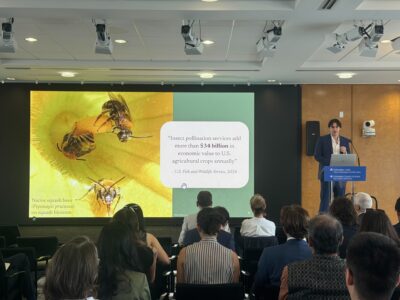During the fall 2014 semester, members of the MPA in Environmental Science class of 2015 conducted campus-wide waste audits to gain a better understanding of student recycling habits. Read an account of the project from Adrian Ang, one of leaders of the waste audit project
****
http://youtu.be/KYA-O1IBXUQ
It is an established fact that having a good routine in the morning is one of the best ways to start on the right foot. Waking up without hitting the snooze button, going for a quick jog before breakfast, reviewing lecture notes before the morning classes at your favorite café — these are all excellent habits to ensure that your body and mind are always ready to take on the day. But quick, can you remember how you disposed of that cup that holds your habitual red-eye cappuccino? Have you ever notice the cardboard sleeve and plastic lid that pack your morning energy boost? You are probably at a loss of words, because your focus was on issues other than waste separation.
In the fall semester, I initiated a research project to learn about the waste separation and recycling habits of the student body, with the goal of transforming these lessons into effective recycling programs that can improve sustainable behavior on and off campus. Assisted by a group of highly energetic and garbage-centric volunteers, we conducted a series of waste audits around Columbia University’s Morningside campus. At the end of the fall audits, we saw interesting patterns emerge from the morass of Chinese food containers, newspapers, and yes, coffee cups.
First, Columbia University students can do a lot more to improve their recycling habits. Across five locations on campus, the average recycling percentage – defined as the proportion of total recyclable waste placed in the appropriate bin – hovers around the 50 percent mark. This means that, for the average student, the probability of throwing that empty coffee cup into either the trash or the paper recycling bin (yes, despite the wax lining, coffee cups can be recycled) boils down to a coin toss. Not something you’d expect from an otherwise educated and socially aware Ivy Leaguer. Second, the students seem to be baffled about separating waste when food enters the equation. During our audits that were conducted after the lunch rush, we saw organic material and accompanying containers were indiscriminately scattered across the three waste streams that are collected in New York (general trash, mixed paper products, and metal/plastic/glass products). Oftentimes, we would see plastic bags containing a plastic drink bottle and utensil, a styrofoam takeout container or paper plate, and a fair share of leftovers, all being thrown into the same waste bin.
I must admit, regrettably, that my own school, the School of International and Public Affairs, had the lowest recycling percentage. The proportion of food waste across all audits was somewhere around 20 percent, and while New York doesn’t have widespread composting, students still have the opportunity to cut down on their waste significantly by visiting the GrowNYC composting station at the Columbia Greenmarket every Thursday and Sunday.
Overall, the underlying causes for these recycling sins boil down to whether or not people give a thought to how they throw things away. I doubt that students take note of the three waste bins in front of them, only to willfully toss their bottled water into the trash. It’s very likely that recycling errors occur because we couldn’t be bothered to figure out which piece of trash goes where, and throw everything into the first open bin that we see. In parts of the city where recycling bins simply don’t exist, the average citizen can be excused for not walking an extra two blocks to throw their newspaper away. But at Columbia University, where trios of black, blue, and green bins are ubiquitous, students should be able spare a moment of thought required to change the angle of their garbage free throw by a few degrees. It is also worth noting that recycling information can be wildly inconsistent, and highly susceptible to the broken telephone effect (Click here for the latest information on recycling in New York).
This semester, we will be rolling out some small recycling interventions to test ways to correct the mistakes mentioned above. This will include more effective ways to communicate recycling information, as well as innovative ways to get students to take the extra second to think about how to separate their waste. As environmental policy students, my classmates and I are always thinking about high-level solutions to the world’s sustainability problems, but I think it’s important to remember that it doesn’t take a Master’s degree to be able to create small increments of positive change at home, at school, or your daily caffeine house.
***
Students in the MPA in Environmental Science and Policy program enroll in a year-long, 54-credit program offered at Columbia University’s School of International and Public Affairs, in partnership with the Earth Institute.
Since it began in 2002, the MPA in Environmental Science and Policy program has given students the hands-on experience, and the analytical and decision-making tools to implement effective environmental and sustainable management policies. The program’s 682 graduates have advanced to jobs in domestic and international environmental policy, working in government, private and non-profit sectors. Their work involves issues of sustainability, resource use and global change, in fields focused on air, water, climate, energy efficiency, food, agriculture, transportation and waste management. They work as consultants, advisers, project managers, program directors, policy analysts, teachers, researchers, and environmental scientists and engineers.
Visit our website for more information: http://mpaenvironment.ei.columbia.edu/



